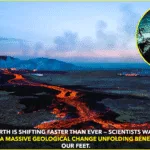New Delhi — In a landmark moment for India’s space ambitions, ISRO is set to launch Vyommitra, an AI-driven half-humanoid robot, into orbit aboard its first uncrewed Gaganyaan mission in December 2025. This bold move signals India’s readiness to take on crewed spaceflight challenges, fast forwarding the nation’s journey toward sending human astronauts into space.
Vyommitra (from Sanskrit vyōma = “space” and mitra = “friend”) is designed to mimic human functions in a spacecraft environment. She will monitor life support metrics — temperature, humidity, pressure, CO₂ levels — interact with spacecraft systems, operate switch panels, and issue alerts or feedback to ground control. www.ndtv.com+3Wikipedia+3Indian Defence News+3
This mission, called Gaganyaan-1 (G1), is part of India’s larger human spaceflight programme. Gaganyaan-1 is slated to orbit at around 400 km altitude for a few days and then return to Earth, using a parachute-based reentry and splashdown in the sea. Indian Defence News+3Wikipedia+3The Economic Times+3
Why This Is Historic
- Robotic stand-in before humans
Instead of risking lives, Vyommitra serves as India’s first “crew” in orbit — a testbed to validate systems for eventual astronauted missions. www.ndtv.com+2The Economic Times+2 - Testing critical systems
Environmental and life support systems are sensitive to microgravity and radiation. By sending a humanoid that mimics human responses, ISRO can evaluate how these systems behave before putting humans on board. Indian Witness+2Indian Defence News+2 - Multi-agency collaboration
The mission involves ISRO along with DRDO, the Indian Air Force, Indian Navy, and other scientific institutions to integrate propulsion, crew escape, safety systems, and recovery operations. Wikipedia+3www.ndtv.com+3Indian Defence News+3 - Ambition toward crewed flight
If G1 succeeds, ISRO plans further test flights and then, by early 2027, intends to send its first astronauts (Gaganyatri) to orbit and return them safely. Wikipedia+4www.ndtv.com+4The Economic Times+4
Technical Preparations & Safety Systems
A significant milestone already achieved is the successful Integrated Air Drop Test (IADT-01), which validated the parachute-based deceleration and recovery system necessary for crew module descent. In this test, a dummy capsule was dropped from a helicopter, and sequential deployment of parachutes slowed its descent for safe splashdown in the Bay of Bengal. The Times of India
These parachutes and recovery systems were developed indigenously by the Aerial Delivery R&D Establishment (ADRDE) in Agra, under DRDO. The Times of India+2The Times of India+2
Further guarantees of safety include a Crew Escape System, redundant modules, and thorough ground testing of all subsystems before any human is cleared to fly. Indian Defence News+2www.ndtv.com+2
Challenges Ahead & Roadmap
Space travel is unforgiving. The phases of ascent, orbit insertion, microgravity exposure, reentry heating, and splashdown each carry risks. ISRO must ensure that life support, structural integrity, radiation shielding, communications, and recovery operations all perform near-perfectly. Wikipedia+3The Times of India+3The Economic Times+3
Additionally, scheduling has seen updates: ISRO has revised its timeline, now aiming for crewed missions in first quarter of 2027, a delay from earlier targets. The Economic Times+2Wikipedia+2
After G1, subsequent uncrewed flights (G2, G3) will refine operations before sending humans. Wikipedia+2Wikipedia+2
What This Means for India
Vyommitra’s journey is more than a scientific experiment — it’s a symbol. It declares to the world: India is not merely a participant in global space efforts, but a bold contender ready to shape humanity’s presence beyond Earth.
It also spurs domestic technological growth: advances in AI, robotics, materials science, radiation shielding, life sciences, and aerospace engineering. As these ripple through industry and academia, they strengthen India’s capacity in space and beyond.
In December 2025, as Vyommitra lifts off, Bharat will proudly showcase its R&D, perseverance, and vision. The world will watch as India steps toward joining the elite club of nations capable of human spaceflight — and perhaps, by the end of the decade, a sustained presence in low Earth orbit.
Stay tuned — history is about to be rewritten.










